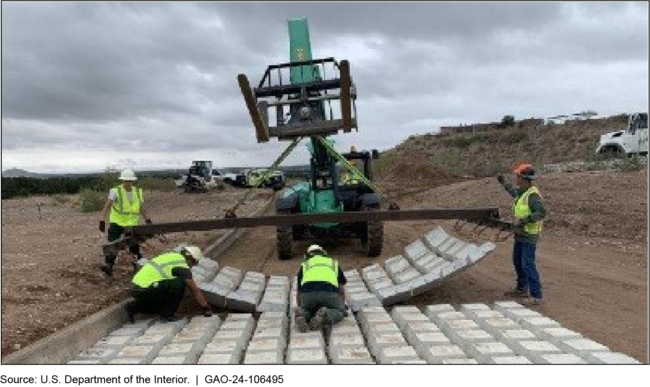Deferred Maintenance: Agencies Generally Followed Leading Practices in Selections but Faced Challenges
Fast Facts
Buildings, roads, and other structures on the federal government's public lands require billions of dollars to maintain each year. Agencies may defer maintenance projects to future years when funds are unavailable.
In 2020, Congress established a fund to address deferred maintenance in fiscal years 2021-2025. The money—as much as $1.9 billion annually—is divided among 5 eligible agencies at 70% for the National Park Service, 15% for the Forest Service, and 5% to each of the other 3 agencies.
Agencies reported they faced challenges to reducing deferred maintenance, such as construction supply chain issues and inflation.
Deferred Maintenance Costs for All 5 Agencies by State, FY 2022

Highlights
What GAO Found
When available funding does not cover the costs of all needed maintenance, a backlog develops, referred to as deferred maintenance. From fiscal years 2019 through 2022, reported deferred maintenance of assets, such as campgrounds and roads on public lands, increased for all five federal agencies that were eligible for the National Parks and Public Land Legacy Restoration Fund (LRF). It increased the most for National Park Service and Bureau of Land Management (BLM), in part due to changes in how agencies reported their data, such as adding a markup to account for project execution costs. For fiscal year 2022, roads and other transportation assets accounted for the most deferred maintenance at BLM and Forest Service.
Road Repair Project at BLM's Las Cruces District in New Mexico

The LRF provides up to and including $1.9 billion per year for fiscal years 2021 through 2025. The agencies' processes to select LRF projects considered factors such as whether they would be too costly to fund using annual appropriations. For example, Bureau of Indian Education had a project with a cost estimate of approximately $70.9 million. This would have amounted to most of the agency's non-LRF funding of $95.3 million for facility improvement and repair in the same year. GAO compared agency processes for selecting projects for LRF funding with six leading practices for managing deferred maintenance and found that these agencies generally followed all six. For example, all agencies identified as part of their processes for selecting projects the risks of not addressing deferred maintenance in a timely manner, such as threats to safety.
Agencies reported they faced challenges to reducing deferred maintenance, such as construction supply chain issues and inflation, which raised costs and delayed projects. However, aspects of LRF program design helped address some challenges. For example, agency officials said contingency funds available for LRF projects allow for more flexibility for agencies to deal with inflation.
Why GAO Did This Study
The federal government manages public lands and assets, such as buildings and roads, that require billions of dollars annually to maintain and operate. Deferred maintenance can diminish the quality of an asset and pose safety hazards, such as unsafe dams and structural deterioration of buildings.
In 2020, the Great American Outdoors Act established the LRF, which provides additional funding to address deferred maintenance during fiscal years 2021 through 2025.
The act includes a provision for GAO to review the implementation of the LRF. This report describes (1) how the amounts and compositions of deferred maintenance for the agencies changed from fiscal year 2019 through 2022, (2) how the agencies selected projects for LRF funding and the extent to which the selection approaches followed leading practices for managing deferred maintenance, and (3) challenges the agencies reported facing in reducing deferred maintenance and how the LRF program design helps to address any challenges.
GAO examined agency data on deferred maintenance and LRF projects and interviewed agency officials. The leading practices GAO used to examine agencies' processes for selecting LRF projects were derived from research by the National Research Council.
For more information, contact Cardell Johnson at (202) 512-3841 or JohnsonCD1@gao.gov.
